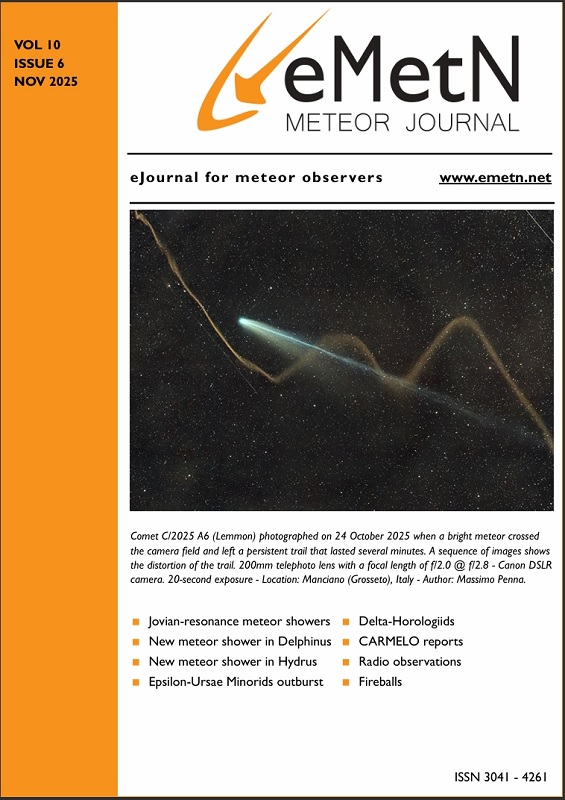Roberto Gorelli points our attention at a recently published meteor related paper.
Rising from Ashes or Dying Flash? Mega Outburst of Small Comet 289P/Blanpain in 2013
This paper has been submitted for publication by Quanzhi Ye (叶泉志) and David L. Clark.
Abstract: Jupiter-family comet 289P/Blanpain was first discovered in 1819 and was then lost for ∼ 200 years, only to be rediscovered in 2003 as a small, weakly active comet. The comet is associated with the Phoenicids, an otherwise minor meteor shower that produced significant outbursts in 1956 and 2014. The shower points to the existence of significant mass-loss events of P/Blanpain in recent history. P/Blanpain was recovered during an apparent large outburst in 2013 July at an appreciable heliocentric distance of 3.9 au, with brightness increase of 9 mag, making it one of the largest comet outbursts ever observed. Here we present an analysis of archival data taken by several telescopes. We find that the 2013 outburst has produced ∼ 10^8 kg of dust, which accounts for a modest fraction (∼ 1%) of the mass of P/Blanpain’s nucleus as measured in 2004. Based on analysis of long-term lightcurve and modeling of coma morphology, we conclude that the 2013 outburst was most likely driven by the crystallization of amorphous water ice triggered by a spin-up disruption of the nucleus. Dust dynamical model shows that a small fraction of the dust ejecta will reach the Earth in 2036 and 2041, but are only expected to produce minor enhancements to the Phoenicid meteor shower. The 2013 outburst of P/Blanpain, though remarkable for a comet at small sizes, does not necessary imply a catastrophic disruption of the nucleus. The upcoming close encounter of P/Blanpain in 2020 January will provide an opportunity to examine the current state of the comet.
You can download this paper for free: https://arxiv.org/pdf/1906.07137.pdf (8 pages).
Older meteor library news:
2019
- Discovery of a Meteor of Interstellar Origin, by Amir Siraj and Abraham Loeb. (10 June 2019).
- A Mathematical Model for Simulating Meteor Showers, by M. Cardinot and A. Namen. (4 June 2019).
- The 2019 Taurid resonant swarm: prospects for ground detection of small NEOs, by David Clark, Paul Wiegert and Peter G. Brown. (28 May 2019).
- Analysis of the June 2, 2016 bolide event over Arizona, by Csaba Palotai, Ramanakumar Sankar, Dwayne L. Free, J. Andreas Howell, Elena Botella and Daniel Batcheldor. (25 May 2019).
- Identifying Interstellar Objects Trapped in the Solar System through Their Orbital Parameters, by Amir Siraj and Abraham Loeb. (5 May 2019).
- Meteor Shower Modeling: Past and Future Draconid Outbursts, by A. Egal, P. Wiegert, P. G. Brown, D. E. Moser, M. Campbell-Brown, A. Moorhead, S. Ehlert and N. Moticska. (1 May 2019).
- Meteoroid structure and fragmentation, by M. D. Campbell-Brown. (24 March 2019).
- Solar cycle variation in radar meteor rates, by M. D. Campbell-Brown. (26 February 2019).
- A New Meteoroid Model, by Valeri V. Dikarev, Eberhard Grün, William J. Baggaley, David P. Galligan, Markus Landgraf, Rüdiger Jehn. (12 February 2019).
- Lunar impacts, by Costantino Sigismondi. (12 February 2019).
- Lunar impact flashes, by C. Avdellidou and J. Vaubaillon. (10 February 2019).
- The Geminid parent body: (3200) Phaethon, by Patrick A. Taylor, Edgard G. Rivera-Valentín, Lance A.M. Benner, Sean E. Marshall, Anne K. Virkki, Flaviane C.F. Venditti, Luisa F. Zambrano-Marin, Sriram S. Bhiravarasu, Betzaida Aponte-Hernandez, Carolina Rodriguez Sanchez-Vahamonde and Jon D. Giorgini. (10 February 2019).
- Sun approaching asteroids and meteor streams, by Quanzhi Ye and Mikael Granvik. (10 February 2019).
2018
- Waiting to make an impact: A probable excess of near-Earth asteroids in 2018 LA-like orbits, by C. de la Fuente Marcos and R. de la Fuente Marcos. (18 December 2018).
- What mechanisms dominate the activity of Geminid Parent (3200) Phaethon?, by LiangLiang Yu, Wing-Huen Ip and Tilman Spohn. (6 November 2018).
- The Draconid meteoroid stream 2018: prospects for satellite impact detection, by Auriane Egal, Paul Wiegert, Peter G. Brown, Danielle E. Moser, Althea V. Moorhead and William J. Cooke (21 September 2018).
- Modeling the measurement accuracy of pre-atmosphere velocities of meteoroids, by Denis Vida, Peter G. Brown and Margaret Campbell-Brown (15 July 2018).
2017
- The Mayas and Eta Aquariids in AD 250-909, by J.H. Kinsman and D.J. Asher (31 July 2017).






